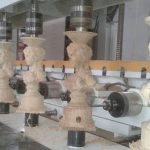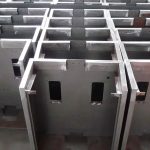
Americans’ design and understanding of systems, especially cross-domain systems, far exceeds China’s.
“The most difficult thing is not product manufacturing, equipment costs, etc., but that in the American system, you can only do it according to the rules of that system’s voice.”
“When a person’s skills support him to reach a high position, he can look down on the entire market, and the career he sees is far different. The United States is actually already in this position.”
1. Compared with domestic factory projects, what are the differences between building a factory in the United States?
Xia Xiaohu: My trip to the United States this time was mainly to help a Chinese company build a factory. From the beginning of planning and construction to the entry of equipment, in 2022 it will enter the stage of entry of various systems. In the past six months, the work we have done mainly includes the debugging, installation, local connection, personnel arrangement and other aspects of some equipment, which is equivalent to the initial start-up work of a factory.
When I first went there, I faced many difficulties, because at that time when I went to the site, the civil construction work was in progress, and the installation of equipment had just begun. The installation of some equipment was still in progress, and the debugging of some equipment had already begun. Not everything was in place, so it was a relatively chaotic state at that time. Including last December, when the epidemic had just been released, everyone was very nervous when we went there. When we arrived in the United States, we had an obvious feeling that it was very different from the domestic environment. One of the key points was the work and rest time.
When doing factory construction in China, it strictly controls the progress of the project and has node-specific requirements. However, we have encountered some difficulties in this regard in the United States. Whether it is the allocation of resources, personnel, or the cooperation between the Chinese and American headquarters and branches, there are some problems. As a result, various progress controls have been affected. It wasn’t until some experienced managers and workers were sent from China to train local employees that all the chaos began to become orderly. About two months ago, things were basically going smoothly.
The impact of the epidemic on factory construction is still very obvious.
First, the overall project was actually delayed for one or two years, and the delivery of various equipment and logistics costs in the early stages of the epidemic were very high. After various equipment arrived at the site, the personnel was not in place, especially the installation personnel and instructors were not in place. It could only be piled on site, and local American workers could only rely on local workers in the United States to return the equipment and adjust it in place. For local workers in the United States, his workload is still quite huge. Because we have a lot of equipment on site, about two to three hundred containers, and in the United States, without the guidance of the leading workers, they were confused about a lot of confusing equipment, which had some impact on the site.
Second, when the equipment is in place and installed, technical personnel should be in place, but it was not until the second half of last year that these personnel were gradually in place. The reasons include the epidemic and visa factors. The visa approval rate is only about 20%. If the United States needs 5 people, the country may need to prepare 20 people to apply for visas. The last 5 people who go may not be in key positions. Our visa is a tourist visa, which does not allow us to work in the United States, we can only do guidance. These people who serve as guides can stay for up to 6 months at a time. In fact, most of their work cannot be completed in these 6 months, but only part of it can be completed, so the country needs to send people there in waves. But this kind of dispatching people one after another has also had a bad effect, that is, everyone has his own way of guidance. I finally brought one worker on the road, and brought out 50% of the work. 80%, and then another person takes the lead, and he changes to another operating habit. In fact, these are some problems caused by insufficient standardization in the production process.
2. Is it difficult to train local workers?
Xia Xiaohu: This process is relatively difficult. The first is language, because China’s grassroots operators have lived in the Chinese environment for a long time, and their growth requirements for bilingualism are not so strict. So after they went there, the first obstacle was communicating with local American workers, but how to assign tasks, what to do, and the way of communication are all Chinese-style. After arriving in the United States, Americans have their own way of communication and need to transform the Chinese way into the American way. If he does not have a working background in an international company, communication will be difficult.
For example, for a product with multiple processes connected in series, the results of the previous process will affect the start of the next process, so it needs to be understood across processes. For example, we fine-tune the previous process based on the ordered products. But for American workers, he has insufficient experience. When he adjusts the process, he doesn’t know why he makes such adjustments. When some workers get started, they think that if you tell me it is one, I will adjust the parameters to one. But the Chinese workers may look at the product because the front is a little larger and I need to adjust it in the next process. Get a little more strength. But this internal connection is not very familiar to new workers in the United States.
Second, American workers are unwilling to cross jobs.
I operate this equipment, and I don’t want to learn the previous equipment. There are two obvious extremes in recruiting workers in the United States. One is ordinary workers. These workers would rather do cleaning work or equipment moving work than do technical work. I go to work at 8:00 in the morning and get off work at 4:30 in the evening, and I get paid by the hour in the factory. I don’t want to work overtime, and my home is relatively close. This may be the mentality of most Americans. This is a job. I rely on this job to sell my labor and get a salary.
There are also some young people who are willing to learn things. Although the United States is a developed country, young people in small towns do not have many opportunities to go out. This is the same as some young people in second- and third-tier cities in China. For young people in the United States, they actually also need a channel. The factory I went to was the largest investment in local history, with more than 300 million US dollars invested. The Chinese are relatively new blood to him. I met several young people in the factory. These people are really willing to learn, but they are not familiar with this product and there are many internal factors. For example, the buttons on the machine are all translated from Chinese, which is difficult to understand. Sometimes I can understand them in Chinese, but I can’t understand them in English. Fortunately, the predecessor of this factory was a military truck manufacturer, and there are more or less some leftover equipment in it. Let’s look at what the button on this equipment says, and then look back at what’s on our equipment. After comparing Chinese and English, I feel that our English is very poor.
3. How to overcome these difficulties?
Xia Xiaohu: When we were on site, the equipment suppliers were basically Chinese companies, because they moved the entire Chinese production system there and were mainly Chinese companies. However, the system that is integrated with cnc machining china‘s production model has become acclimatized in the United States. For example, in China, our system may have some data presented in tables, and some data imported from other systems. After arriving in the United States, I found that they were confused about many Chinese characters in the table data, so I could only use some The graphical interface allows him to perform some operations, and we found that we can actually do without those tabular data, which is also an improvement for us. Then we discussed internally how to optimize my human-machine interface. Everyone found this process smooth, including our domestic debugging personnel.
Word of mouth is very important. Without basic bilingual communication, there are significant barriers. Because the people I contacted were mixed, I fell into a kind of confusion. Some people could understand English, and I could speak English to them. Some people were immigrants from Mexico, and some were immigrants from other places, and he could not speak English either. You must be able to fully understand English, and you must find a translator. How can our Chinese enterprises overcome language barriers, standards barriers, and lifestyle habits barriers when they go global in the future? In fact, these can only be overcome by time.
For latecomers, it is necessary to make full use of the power of Chinese Americans. There are many Chinese Americans on site. First, they have relatively few language communication barriers. Second, they are used to that kind of lifestyle. In fact, it only takes about 18 months to get used to this lifestyle.
4. Does the United States work a lot of overtime?
Xia Xiaohu: In the first five months, I thought they didn’t work overtime, but in the sixth month, I started to have a little change. I think whether to work overtime mainly depends on communication and management. for example. There is an electric furnace in our process. After it is turned on, it must be kept uninterrupted for 24 hours until the next overhaul. Someone will definitely have to work the night shift.
Wages in the United States are calculated based on hourly wages. The wages for night shifts are multiplied by 1.5, and sometimes even more, so his income is higher. At first I thought not to take so many classes a week, but to take 4 or 3 days so that you can have a good rest. But they are counting on me working four days of night shift this week. After all, the salary is about the same as if I worked day shift. But if I don’t work for the next three days, it’s equivalent to wasting my time. I might as well work the day shift. Later, a local Chinese told us, he said, don’t arrange it like this. You arrange for him to work night shifts for 6 consecutive days, and then pay you the normal salary for 8 hours. The extra 4 hours will be paid at 300% and 150%. %, and then he calculated it like this, I could earn more than 4,000 yuan originally, and after working the night shift, I could earn more than 6,000 yuan. If I calculate it, I am willing to do it. The places are quite popular. The accounting methods are different. Enterprises calculate the cost of the enterprise, while workers calculate the opportunity cost.
In fact, the hourly wage system affects a relatively wide range of areas. For example, if I work in a supermarket to tally goods, I work in a restaurant or help others weed, or do house repairs or work in a factory, I basically The income is about the same.
5. What is the approximate salary level of American industrial workers?
Xia Xiaohu: It’s about 18 to 23 US dollars an hour. The manufacturing industry in the United States does not have a great job market, but not everyone can work in supermarkets. The wages will be relatively low at the beginning. Later, Tesla will build a new factory nearby, and the wages they will offer will be higher. , which can reach 23~27 US dollars per hour. At 20 US dollars an hour, that works out to 240 US dollars a day and 22 days of work. After tax, that works out to 4,000 to 5,000 US dollars a month. The absolute cost is obviously higher than that in China. Domestically, it is considered good to get 7,000-8,000 yuan a month in Guangzhou.
A big impact we face is the income gap. The aunt who is responsible for office cleaning can earn more than 3,000 US dollars a month, which is much higher than me. In China, I can design a production line and lead a production process, but here my salary is not as good as that of a cleaner. This is how it feels. The client’s boss also told me that you should stay, but actually I don’t want to, because in the United States, you earn US dollars and spend US dollars, and its cost of living, housing, and transportation are actually not available in China. Fabi’s.
I have a colleague in the United States who drives for two hours on the expressway to and from get off work every day. In other words, driving nearly 300 kilometers a day is actually a drain on people and the car. Prices in the United States have risen dramatically over the past few years. When I went there in 2016, I felt that most things were cheaper than in China, and I felt like I was getting money for everything I bought there. This time I went, I found that except for Apple mobile phones and Apple iPads, nothing is cheaper than in China, and clothes are not cheap anymore. If I were asked to find a job locally, I might get a relatively high salary. I also looked at the annual salary I could get of $300,000.
Han Shulin: When we study the manufacturing industry, the per capita efficiency of the U.S. manufacturing industry is 6 times that of China, and wages are also 6 times that of China. In this way, labor wages in China and the United States are almost the same.
6. What is the quality or ability of American workers? If the quality is not high, why is the manufacturing industry so strong?
Chen Chen: When Lao Xia went to the United States, he made some contrasts. The first is that the local workers are not very professional and their knowledge system is not very complete. For example, those who install network cables do not know how to install them. At that time, the on-site workers were still old summer installers. The second is that the quality of people varies. For example, some people punch in and disappear after going to work, and then disappear again in the afternoon after having a meal at noon. Their degree of diligence in work is not particularly high. Another example is the workers drilling holes in the steel plate. They didn’t even drill a single hole in a day, and they had to go to Youtube to check how to drill holes.
Xia Xiaohu: I think most American workers are not as efficient as Chinese workers. Of course, this does not mean that all Chinese are not lazy, nor that Americans are not hardworking. When we went to the United States, there was a lot of civil work in the workshop that needed to be reworked. This rework was because the previous work was unprofessional, resulting in some underground projects not being done well. In the first three months, my ears were filled with the sound of various machines, because I had only completed a few pits for three months. At that time, I really couldn’t figure out what they were doing. It will be repaired for you in two weeks in China. Many domestic equipment in our country use electricity, while the United States likes to use oil-burning equipment. If you think about a gasoline engine, start it and then cut it on the ground, the noise will really reverberate throughout the workshop. My working position at that time was very close to it, and I wore a lot of earplugs in my ears.
Chen Chen: I read a joke. He said what would happen if there was no electricity in the world? Someone made some animations about refrigerators burning oil, printers burning oil, and toasters also burning oil.
Xia Xiaohu: They do have such a living habit. I also talked to the workers and asked, why don’t you use electricity? He said we don’t have electricity. This brings up another topic: Why are pickup trucks so popular in the United States?
Some people in the United States are labor workers. They will bring their own tools and go to the site to work for 5 to 10 days. After the work is completed, they will change to another factory. He brings his own tools. Even if there is electricity in our factory, he will bring his own generator, which is hard to understand. Because this is his equipment, he may have signed a contract with us that does not include our on-site power supply. On site, the electricity was being generated for a day. I said that I could provide you with power, but you stopped generating electricity and asked me to be quiet. He would say that the contract states that we generate our own electricity.
It is precisely because of this method that there is a group of people who need to tow a car. Why do Americans have so many pickup trucks? It is found that pickup truck drivers basically have such demand. There are also some service teams, such as those who repair houses. On the highway, we will also see a pickup truck with four or five lawnmowers behind it.
7. Can Americans squat down?
Xia Xiaohu: It’s true that they can’t squat. They kneel on the ground. When I first saw them lying on the ground, I felt very strange. Does your knee hurt when you lie on the ground? When I got closer, I saw that there was a mat under my knees, and I drew lines on the ground. This is what they are used to doing.
Another habit is dependence on things. The example of drilling holes in steel plates is incredible to me. I want to know if he is inefficient, intentional, or just an operating habit. At the beginning, my judgment was that these people were lazy and just idle workers. We Chinese can drill holes in it, maybe in three strokes, five divisions and two, and we can drill 200 or 300 holes in a day. For them, they may not be able to hit 40 people a day. From the beginning, they just work hard and hit people who don’t know where they are. Then you have to find him for mobile phone positioning. After contacting more people, I began to slowly have some changes. I can only say that he is not professional, and he never knew it. A person who seems very simple to you does not have this skill. Just like when we were making network cables at the beginning, we connected with local informatization personnel. One of the most important tasks in informatization was to pull network cables and lay them out, and then I would teach them. Later I found out that he didn’t do it either, because their informatization mainly involved some docking work. He outsourced the matter of pulling network cables to a professional team, and it was actually not under his control. According to Chinese people’s habits, communication equipment is classified as information technology. In fact, in the United States, it is divided into two types of work. I talked to some local people who make security systems, but he didn’t know how to do it either.
Han Shulin: I sometimes come into contact with some media, and they keep holding meetings to plan and then do things. Chinese people may have fewer meetings, and then go to the scene to do it themselves. Why Lao Xia said he could get a salary of hundreds of thousands of dollars in the United States is because he knows so much and has so many skills. The division of labor in the United States is very detailed, and it’s not just about skill levels, but different systems. You said that if you were to draw lines on the floor, you might not be able to draw them better than him, right? His division of labor system is different, so I think this area may not only be about high or low efficiency.
8. What is the U.S. supply chain like?
Xia Xiaohu: The U.S. supply chain is indeed a big problem. In terms of personnel, I will give him an excuse for the time being because the division of labor is wrong, but when it comes to machines and materials, I think it really doesn’t work. We bought an American brand server because we needed to deploy the system in China in advance, so we bought it in China. The American server we bought in China broke after it arrived in the United States. Because it was left on site for a long time, there was a lot of dust. The final judgment It turns out the motherboard is broken. I’ll call him from the United States. We bought three years of service and asked him to come to our door. When he checked, he said that your product is registered in China and it has a global joint warranty, but you have to move the warranty in China to the United States. OK, I will migrate. Our equipment failed at the end of April, and the migration has not been completed yet.
Because I bought it through e-commerce channels in China, when I submitted the migration data to the United States, something was wrong here and there. It took 15 working days for each data submission, so you just have to wait. If you make a domestic call, you will be told that your product is not in China. If you call the United States, you will be told that your service is not in the United States. Then you can only wait. If someone comes to your door within two days in China, they will serve you the next day and provide you with a solution right away. But in the United States to this day, we are still discussing what to do with the server when we have a meeting today? If you buy a new server of the same product in the United States, the price is three times that of a domestic server.
So let me tell you this, except for the iPad we bought in the United States to use as an operating terminal, I would rather buy everything else from China and then have it shipped to the United States by air as quickly as possible, which is more economical than purchasing it in the United States.
I purchased a sensor from Germany to China, and the Chinese branch will have it in stock. But when I purchase from China, if I go to the United States, the United States generally doesn’t have the goods in stock, or maybe we haven’t found the right channel. We mobilized a lot of local resources in the United States to find this product, but we couldn’t find it. If you find a reason for him in this regard, it may be caused by different living habits.
If you want to do some scattered processing in the United States, it will be more difficult. Each of its products must be made by a professional company with professional machines and professional personnel, and then a professional system will deliver it to your hands, and a professional person will be sent to install it for you. good. Every step feels like a high cost, and this cost is actually passed on to the entire industrial manufacturing. This includes personnel costs, time costs, and some transportation costs. Why is the United States called a “country on wheels”? I think it is more because its transportation industry is particularly developed, with many trucks and containers.
9. Will this extreme division of labor bring any benefits?
Xia Xiaohu: When a person is very focused on his product, he will try to make it as low-cost as possible and even make it serialized as much as possible. I designed it with a more reasonable structure and a way that is easier to produce, and then made the production process cost low enough and the materials used low enough.
For manual power tools like electric hand drills, first of all, it has a wide range of categories. Secondly, it has many models and options for the same function, and its accessories are also very comprehensive. When we looked at the workers on site, half of the tools they used were things I had never seen in China. Some are really useful, but why? This brand will specifically study this tool, dig out its needs in different application scenarios, and design a product after digging it out. Although in the end you will find that this product may be Made in China, the design is in There he is. But in fact it doesn’t have much use in China, because the Chinese will solve this problem in another way. Just like the gasoline engine cutting machine I just mentioned, the Chinese will not use it.
10. Comparing Chinese and foreign manufacturing industries, what makes the United States so inefficient?
Chen Chen: You just mentioned machining. Maybe in places like the Yangtze River Delta and the Pearl River Delta in China, it is easy for me to find many small suppliers to do this. But when you build a factory there, if the suppliers don’t have If there is a quality assurance system and a safety guarantee system, he cannot stand for election. Is there such a constraint that leads to a lack of flexibility, or do you think he has low flexibility due to his ability and local working methods?
Xia Xiaohu: Maybe it’s more because of their habits. They have been surviving in this way for many years, and he has always done things this way. For Chinese people, it is really a new field in some aspects. How you view it and how you get used to it is really important.
When we are on site, for example, if you drive a forklift, they also know that they must be professional and trained. What kind of certificate do I need to have before I can drive this forklift? Then you will find that there are many of them. The same goes for people. In other words, I really have to abide by the rules and regulations from the bottom of my heart.
11. Is the supply of local digitalization in the United States, such as ERP, system integration, smart manufacturing, smart logistics, AGV and other equipment software, abundant and strong?
Xia Xiaohu: Informatization, MAC systems, and ERP systems in the United States are relatively common among American companies because their enterprise informatization is actually highly developed. Local companies in the United States, including some large companies, all have professional suppliers to do such things. They try their best not to need anyone to take inventory. Because it is a cost issue when you use people to take inventory, but for China, using this system will increase costs. It is better not to use this system. But for some things, such as the smart manufacturing we are promoting in China, called information system interconnection, the United States actually has problems with its supply capacity, and there are relatively few entrepreneurial companies in this area.
Local Americans may think that this direction is not very popular with investors, but some investors are more willing to invest in China because China has been constantly promoting this matter. When it comes to the so-called industrial Internet information and physics, including digital twins, he has this kind of theoretical research, but I remember one person said something, that is, IT staff, you have to find a way to get your hands dirty. That is to say, you must go deep into the practical process and you must implement it. For him, this is a very high-cost thing. You have to have a team that can sustain it and continue to do such things. We also have this problem in China. There are many industrial Internet platforms. They are not willing to get their hands dirty. They are not willing to go to the site. I would rather take it off and subcontract it to other teams. Programmers do not want to get it dirty. willing to go. This dilemma may not only exist in the United States, but China may also reach this point sooner or later.
From this matter, I also saw a market opportunity. That is to say, China is now promoting smart manufacturing and production informatization. In the short term, what we may see is just replacing manpower to improve efficiency. When it becomes popular, it may bring some other improvements, just like electric cars. . I used to have a job that dealt with batteries, and at that time we started making electric bicycles. At that time, I couldn’t see what kind of big changes it would bring. I only thought that it saved fuel and replaced the engine. I couldn’t see anything else. As a result, now you will find that after my electric drive has broken through a hurdle, I have entered a realm where my skills can be freely used.
Maybe in industrial intelligent manufacturing, when we break through a lot of things like IoT, communication, control, and theory at the production site, you may also enter a space where you can play freely. I think one possibility is our MAC system and our ERP system. Where is the source of its data? If its source comes from production equipment, is it possible for us to seize the source? We may enter another region. One is the source triggered by the demand side, and the other is the source triggered by the supply side. When these two sources are finally brought together on a platform, it is another matter.
12. Is the U.S. manufacturing industry in decline?
Xia Xiaohu: From what I know about the American manufacturing industry, the first one is that its manufacturing scale is actually quite large. Including some factories we see in the United States, they all have a certain background. For many of its product designs, whether they are consumer goods, consumer goods or industrial products, a very important part of it lies in its gold content. The first is manufacturing and process principles; the second is industrial design; the third is manufacturing; and the fourth application may be considered from these perspectives. The first two are very well done, and it may mean that I Design it out, just like a power tool, I design it out and make it in China.
Americans’ design and understanding of systems, especially cross-domain systems, far exceeds China’s design capabilities. You can see it from the system of a large American company. It has a performance and a technical parameter. We can only use it occasionally under very complex, unique, and extreme working conditions, but he has considered it. Well, this may be something that Chinese companies need to learn from. The United States is indeed very strong in this regard.
Han Shulin: Since downstream professionals have specialized requirements or special requirements in this usage scenario, it can form scale in subdivided fields.
Xia Xiaohu: Some time ago, we were talking to colleagues in the United States. I said that my salary in the United States is really not even as good as that of a cleaner, so I might as well come to the United States to work. Then they said that when you come to the United States, you can stand at a relatively high position and go see the ordinary industrial production and manufacturing below. In fact, it means that when a person’s skills reach a very high position, he can overlook the entire market, and the career he sees is far different. The United States is actually already in this position. What he sees is based on all his previous accumulation. He knows where it will be. He is looking down on this market, and many of our Chinese companies are looking up. I am looking at what is at the top. , I can’t understand the scenery on the 20th floor when I’m on the first floor, but when I’m on the 20th floor, I understand the scenery on the dozen or so floors very well, I think it’s like this. There are many novel industrial drive products in Guangdong, including other domestic companies. It has many novel special aircraft. Because he is already familiar with this area, he knows how I will make it diverse in the future. I do all kinds of professions.
So why don’t I go to Africa? I have such good resources as China, I have such a good manufacturing foundation in China, and I have so many products. I have not reached the 20th floor, but I am on the 10th floor. When I go to see Africa, I will find that I can use Our Chinese products have raised the entire African society to a higher level, and the market space created in the process is very huge. The manufacturing industry in the United States is at a high place in the front, and its accumulation may be something that we cannot understand and cannot see. It may take us a few years before we can see as much accumulation as others have, so The things taught are very new to us. Its premise is that it has so much accumulation, and it knows that some things are useless after being handed over, and what things are needed in the future.
Chen Chen: There is a company in Guangzhou that impressed me deeply. It took them two or three years to enter the supplier system of an American company. They don’t just assess whether your product meets the standards, they even want to see the quality and safety of the entire process in your factory. Then my test data for you is more than 100 pages, a very detailed assessment. I think this may also be an accumulation of it.
Xia Xiaohu: Mainly reflected in various inquiry books, some quotations will give you a very detailed one, and then you will find that actually I only need one parameter in it. I have worked for a German company before. This German company has been in business for more than 100 years. It has been doing one thing. The products it makes have become more and more simplified from confusion at the beginning, but the branches of technology are becoming more and more lush. Then you will find that under the lush tree of technology, this product is actually the same no matter where it is produced. In this case, if you want to get product information, it is actually just a value that is useful to you. But for a system like this in the United States, is it efficient or inefficient in the United States? What method should it use for the future development of industry? It is impossible to say whether a large tree with leafy branches is better or a small branch. There may be different survival methods for different products. For a team that draws the line, it is ok if he is responsible for drawing the line well. But for a company that makes machines, it must consider more aspects, maybe its technical demeanor, which may be different, but it’s hard to say clearly.
13. Is bringing manufacturing back to the United States really happening?
Chen Chen: It’s really happening. We have encountered some companies that, in order to gain access to the U.S. market or enter the U.S. supply chain, have begun to invest more in places outside China, such as Vietnam and Mexico. This is actually happening. And a few days ago, my friends were investigating some large multinational companies. They invested in many projects in China, but they also invested in many projects in the United States. Because judging from some data on the Internet, including some assessments made by the United States’ own think tanks, it has been proven that the U.S. manufacturing industry must be recovering or returning. The number of industrial buildings in the United States is also expanding, and the number of American workers has increased by hundreds of thousands every year in the past two years. They include a reshoring index, which shows that the US manufacturing industry, including the growth of US domestic industry and the growth of imports, exceeds the growth of population.
I would like to talk about a few issues in the United States. Can the industrial chain support American manufacturing?
I think the industrial chain in the United States is actually in the book we translated before (“Manufacturing Prosperity”). He gave data on the decline of various industries, and the reality that Lao Xia said no matter how he gave him reasons, he couldn’t buy it. A sensor cannot create a production-oriented service industry. From another perspective, it is still very powerful in the original system. For example, regarding its control over technology, if we return to the semiconductor market, the number one company in its field is an American company, the second one may be a Japanese company, and the third one is still an American cnc machining company, so the top three are Famous and beautiful. Then you can see that it really started in the 1860s. At that time, after the systematic development of the American semiconductor industry, the United States defined the standard processes and usage scenarios of materials. We have seen the impact of the United States on the industrial chain. A lot of power is invisible. In terms of truly tangible things, China has completely surpassed the United States. In the intangible field, we now see that the United States still has some very strong basic industrial software standards, and even the entire knowledge, including some codable knowledge, including some habits, and even Regarding the habits in some industries, I think the United States actually has very strong control in this regard.
We went to many parts companies, all of which are at the very end. He said that the most difficult thing for us now is not product manufacturing, equipment costs, etc., but that in the American system, you can only follow the words of his system. Do it according to the right rules. Business logic, manufacturing processes, and product application methods are all determined by others.






